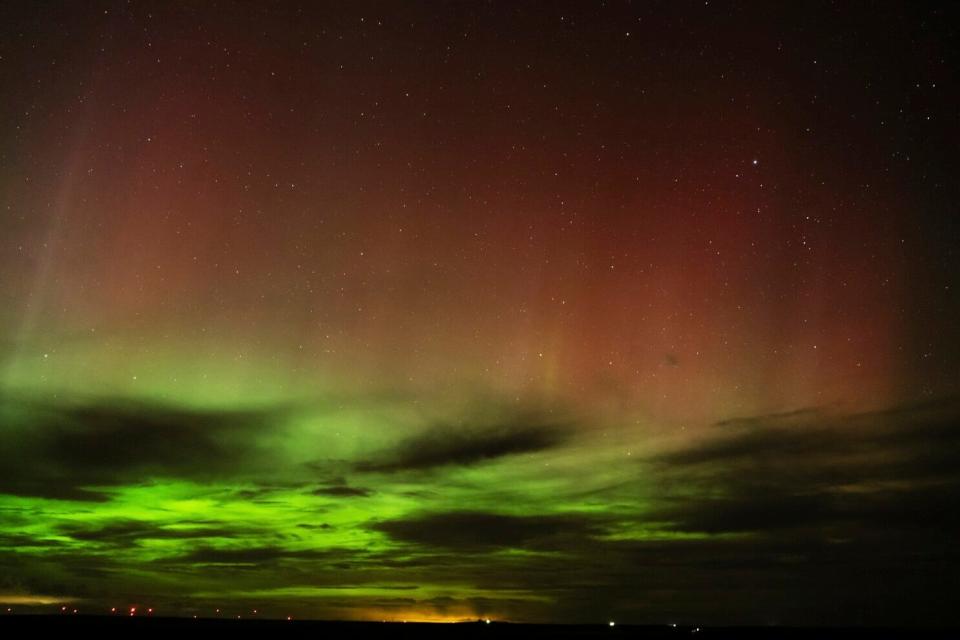Seeing the northern lights in Massachusetts? There was a minimal chance of that this week
For awhile, it looked like MetroWest residents would get a rare chance this week to view an atmospheric phenomenom that is typically reserved for trips inside the Arctic Circle. But local weather forecasters are now saying it's highly unlikely.
The northern lights, referred to in scientific circles as aurora borealis, had a chance to be visible in Massachusetts on Wednesday and Thursday nights, thanks to enhanced geomagnetic activity that would allow those further south than usual to view the activity.
Lawrence McKenna, a professor at Framingham State University who teaches a course on solar system astronomy, said that to get the best chance at viewing the lights, residents should try to find an area that will have the least amount of light pollution possible.

'Seen best at a dark location': Astronomers say Lyrid meteor shower can be seen through April 29
"The answer to being able to see the lights is darkness, and heading north," he said. "Everybody who wants to see these things have to be in the darkest skies they can find, and it really matters how dark it is. Everybody is used to seeing photographs of the northern lights, which are bright and powerful, but that isn't how they look to the naked eye — they are very faint, so you need to have the darkest skies you can find. If you are serious about it, drive out of town a little bit and find a dark spot."
McKenna said it also helps to be at a higher elevation, and to have the ability to look north, which is where the lights are going to be located in the sky.
"If you don't know where north is, take out your phone and point it north, but you've got to be able to see north," he said, adding that the northern lights will be "low on the horizon."
"If you imagine putting your hand with all your fingers together, and putting it on the northern horizon, the lights are not going to be any higher than the top of your hand, held at arms length," McKenna said. "They are going to be faint, but they are absolutely worthwhile. They are one of the most spectacular things you can see with the naked eye."
What creates the northern lights?
McKenna said the energy that creates the northern lights comes from the sun, and is a symptom of the sun's typical cycle.
"The sun has a bad case of acne right now," he said. "The sun has a natural 11-year cycle, and right now it's in the part of the cycle where the sun's magnetic field is begging to squeeze out past the surface of the sun, because it is at a maximum of solar activity. The places where it squeezes out are called sun spots, and they look like little acne on the surface of the sun."
'Terrible light pollution problem': Astronomers, others hope that legislation addresses the night sky
The breakouts on the sun send out enormous qualities of charged particles into space, McKenna continued. If the Earth flies through one of the explosions of charged particles, the particles collide with the Earth's magnetic field, which acts as a barrier. Particles are then funneled down to the North or South Pole of the Earth, and as they hit the poles, they strip oxygen and nitrogen atoms of the Earth's atmosphere of electrons, and when the electrons recombine, they emit light, which are the northern lights.
"The probability of being able to see the northern lights further south depends on the density of the particles, and when the sun is in its active stage that is right now, that is more likely as more strong particles come out more frequently," McKenna said.
Where should I look to see them?
The northern lights are typically visible inside the Arctic Circle in places such as Alaska, northern Canada and Scandinavia. In addition to being much closer to the North Pole than Massachusetts, there is also significantly less light pollution in those areas, allowing for clearer viewing.
The Geophysical Institute at the University of Alaska at Fairbanks has forecast auroral activity on Thursday in 17 states: Alaska, Oregon, Washington, Idaho, Montana, Wyoming, North Dakota, South Dakota, Minnesota, Wisconsin, Michigan, New York, New Hampshire, Vermont, Indiana, Maine and Maryland.
McKenna said the more rural a location, the better, given the need for dark skies. Areas in the immediate proximity of larger communities, such as Framingham, Milford and Marlborough, are unlikely to provide very good views. But heading north of Framingham, even to Sudbury, Maynard and Stow, or northwest to Berlin and Bolton, provides far less light pollution locally.
Other areas to look for include natural preserves that are unlikely to have much light pollution, such as at Hopkinton State Park, Farm Pond in Sherborn and Lake Winthrop in Holliston.
McKenna added that while driving north to New Hampshire, Maine or Vermont would increase the likelihood of seeing the lights, it would all be for naught if Wednesday or Thursday evening are cloudy.
"The very first thing you should do is go to the National Weather Service and see if it's going to be cloudy, because if it is, don't even bother leaving home," McKenna said.
This article originally appeared on MetroWest Daily News: Northern lights visibility in MA forecast ended up changing

